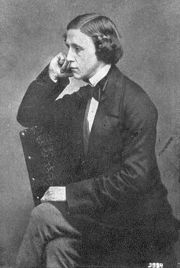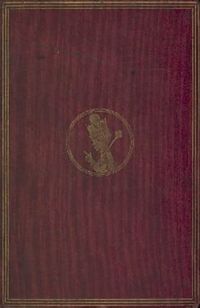THROUGH THE LOOKING GLASS (AND WHAT ALICE FOUND THERE) Complete tex. Written by Lewis Carroll and released in 1872.
Charles Lutwidge Dodgson (‘Lewis Carroll’) – believed to be a self-portrait
Original Cover for Through The Looking Glass
CHARLES DODGSON – AKA LEWIS CARROLL
Charles Lutwidge Dodgson (January 27, 1832 – January 14, 1898), better known by the pen name Lewis Carroll, was an English author, mathematician, logician, Anglican clergyman, and photographer.
His most famous writings are Alice’s Adventures in Wonderland and its sequel Through the Looking-Glass as well as the poems “The Hunting of the Snark” and “Jabberwocky”, all considered to be within the genre of literary nonsense.
His facility at word play, logic, and fantasy has delighted audiences ranging from children to the literary elite. But beyond this, his work has become embedded deeply in modern culture. He has directly influenced many artists.
There are societies dedicated to the enjoyment and promotion of his works and the investigation of his life in many parts of the world including North America, Japan, the United Kingdom, and New Zealand.
His biography has recently come under much question as a result of what some call the “Carroll Myth.”
THROUGH THE LOOKING GLASS – PLOT SUMMARY
Alice ponders what the world is like on the other side of a mirror, and to her surprise, is able to pass through to experience the alternate world. She discovers a book with looking-glass poetry, “Jabberwocky,” which she can read only by holding it up to a mirror. Upon leaving the house, she enters a garden, where the flowers speak to her and mistake her for a flower. There, Alice also meets the Red Queen, who offers a throne to Alice if she just moves to the eighth rank in a chess match. Alice is placed as the White Queen’s pawn, and begins the game by taking a train to the fourth rank, since pawns in chess can move two spaces on the first move.
She then meets Tweedledum and Tweedledee, of whom she knows from the famous nursery rhyme. After reciting to her the long poem “The Walrus and the Carpenter,” the two proceed to act out the events of their own poem. Alice continues on to meet the White Queen, who is very absent-minded and later transforms into a sheep.
The following chapter details her meeting with Humpty Dumpty, who explains to her the meaning of “Jabberwocky,” before his inevitable fall from the wall. This is followed by an encounter with the Lion and the Unicorn, who again proceed to act out a nursery rhyme. She is then rescued from the Red Knight by the White Knight, who many consider to be a representation of Lewis Carroll himself.
At this point, she reaches the eight rank and becomes a queen, and by capturing the Red Queen, puts the Red King (who has remained stationary throughout the book) into checkmate. She then awakes from her dream (if it had been a dream), and blames her black kitten (the white kitten was wholly innocent) for the mischief caused by the story. The two kittens are the children of Dinah, Alice’s cat in the first book.
POEMS AND SONGS
* Prelude
* Jabberwocky (seen in the mirror-house)
* Tweedledum and Tweedledee
* The Walrus and the Carpenter
* Humpty Dumpty
* “In Winter when the fields are white…”
* Haddocks’ Eyes / The Aged Aged Man / Ways and Means / A-sitting on a gate (see Haddocks eyes) The song is A sitting on a gate, but its other names and callings are placed above.
* To the Looking-Glass world it was Alice that said…
* White Queen’s riddle
* “A boat beneath a sunny sky”, the first line of a title-less poem at the end of the book that is an acrostic: the beginning letters of each line together spell Alice Pleasance Liddell.

